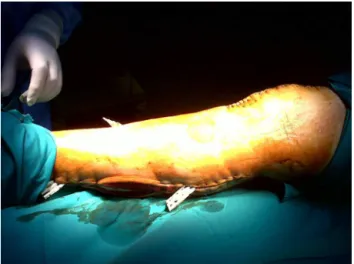rev bras ortop.2015;50(4):478–481
w w w . r b o . o r g . b r
Case
Report
Compartment
syndrome
after
total
knee
arthroplasty:
regarding
a
clinical
case
夽
Ana
Alexandra
da
Costa
Pinheiro
∗,
Pedro
Miguel
Dantas
Costa
Marques,
Pedro
Miguel
Gomes
Sá,
Carolina
Fernandes
Oliveira,
Bruno
Pombo
Ferreira
da
Silva,
Cristina
Maria
Varino
de
Sousa
UnidadeLocaldeSaúdedoAltoMinho,VianadoCastelo,Portugal
a
r
t
i
c
l
e
i
n
f
o
Articlehistory: Received23June2014 Accepted18August2014 Availableonline10July2015
Keywords: Kneearthroplasty Knee
Postoperativecomplications
a
b
s
t
r
a
c
t
Althoughcompartmentsyndromeisararecomplicationoftotalkneearthroplasty,itisone ofthemostdevastatingcomplications.Itisdefinedasasituationofincreasedpressure withinaclosedosteofascialspacethatimpairsthecirculationandthefunctioningofthe tissuesinsidethisspace,therebyleadingtoischemiaandtissuedysfunction.Here,aclinical caseofapatientwhowasfollowedupinorthopedicoutpatientconsultationsduetoright gonarthrosisispresented.Thepatienthadahistoryofarthroscopicmeniscectomyand pre-sentedkneeflexionof10◦beforetheoperation,whichconsistedoftotalarthroplastyofthe rightknee.Theoperationseemedtobefreefromintercurrences,butthepatientevolved withcompartmentsyndromeoftheipsilaterallegaftertheoperation.Sincecompartment syndromeisatruesurgicalemergency,earlyrecognitionandtreatmentofthiscondition throughfasciotomyiscrucialinordertoavoidamputation,limbdysfunction,kidneyfailure anddeath.However,itmaybedifficulttomakethediagnosisandcasesmaynotbe recog-nizedifthecauseofcompartmentsyndromeisunusualorifthepatientisunderepidural analgesiaand/orperipheralnerveblock,whichthuscamouflagesthemainwarningsign, i.e.disproportionalpain.Inaddition,edemaofthelimbthatunderwenttheinterventionis commonaftertotalkneearthroplastyoperations.Thisstudypresentsareviewofthe liter-atureandsignalsthatthepossiblerarityofcasesisprobablyduetofailuretorecognizethis conditioninatimelymannerandtoplacingthesepatientsinotherdiagnosticgroupsthat arelesslikely,suchasneuropraxiacausedbyusingatourniquetorperipheralnerveinjury. ©2014SociedadeBrasileiradeOrtopediaeTraumatologia.PublishedbyElsevierEditora Ltda.Allrightsreserved.
夽
WorkperformedintheOrthopedicsandTraumatologyService,UnidadeLocaldeSaúdedoAltoMinho,VianadoCastelo,Portugal. ∗ Correspondingauthor.
E-mail:ana.alexandra.pinheiro@gmail.com(A.A.d.C.Pinheiro). http://dx.doi.org/10.1016/j.rboe.2015.06.017
rev bras ortop.2015;50(4):478–481
479
Síndrome
de
compartimento
após
artroplastia
total
do
joelho:
a
propósito
de
um
caso
clínico
Palavras-chave: Artroplastiadojoelho Joelho
Complicac¸õespós-operatórias
r
e
s
u
m
o
Apesardeasíndromedecompartimentoserumacomplicac¸ãoraradaartroplastiatotaldo joelho,essaconstituiumadascomplicac¸õesmaisdevastadoras.Asíndromede comparti-mentodefine-secomooaumentodapressãodentrodeumespac¸oosteofascialfechadoque comprometeacirculac¸ãoeafunc¸ãodostecidosdentrodesseespac¸oeconduzàisquemia eàdisfunc¸ãotecidular.Osautoresapresentamumcasoclínicodepacienteseguidaem consultaexternadeortopediaporgonartrosedireita,comantecedentesdemeniscectomia artroscópicaecomflexãode10◦dojoelhopré-operatório,quefoisubmetidaaartroplastia totaldojoelhodireito.Acirurgiaaparentementedecorreusemintercorrênciase o pós-operatórioevoluiucomsíndromedecompartimentodapernaipsilateral.Sendoasíndrome decompartimentoumaemergênciacirúrgica,oseureconhecimentoetratamentoprecoce pormeiodefasciotomiaséfulcralparaevitaraamputac¸ão,disfunc¸ãodomembro, insufi-ciênciarenalemorte.Noentanto,odiagnósticopodeserdifícilenãoreconhecidoperante umacausaincomumdesíndromedecompartimento.Quandoopacienteestásob anal-gesiaepidurale/oubloqueionervosoperiférico,camufladessemodooprincipalsinalde alarme,adordesproporcional.Alémdisso,oedemadomembrointervencionadoécomum nopós-operatóriodeartroplastiatotaldojoelho.Osautoresrevêmaliteraturaealertam queapossívelraridadederelatosdecasossedevaaomaisprovávelnãoreconhecimento precocedessaidentidadeeaoenquadramentodessesdoentesemoutrosgrupos diagnós-ticosetiologicamentemenosprováveis,comoneuropraxiaporusodegarroteoulesãode nervosperiféricos.
©2014SociedadeBrasileiradeOrtopediaeTraumatologia.PublicadoporElsevier EditoraLtda.Todososdireitosreservados.
Introduction
Compartment syndrome is defined as increased pressure insideaclosedosteofascialspacethatcompromisesthe cir-culationandthefunctioningofthetissueswithinthisspace, therebyleadingtoischemiaandtissuedysfunction.1–3Itisa
severecomplicationthatrequiresdecompressionfasciotomy inordertopreventtissuenecrosis.
Correctearly diagnosis ofthis entity isvery important, becausedelayindiagnosingitistheonlycauseoftreatment failure.Thediagnosisisessentiallyclinical,bymeansof anam-nesis and physicalexamination, and is confirmedthrough measuringthepressureofthecompartment(s).4–9
Case
report
Thepatientwasa65-year-oldwomanwithahistoryof right-sidearthroscopicinternalmeniscectomy,whichwasfollowed upthrough orthopedicoutpatientconsultationsbecause of right-sidethree-compartmentgonarthrosis.Beforethe oper-ation,shepresentedsevereright-kneestiffness,withflexion of20◦andmaximumflexionoflessthan90◦.
Thepatientunderwentright-sidetotalkneearthroplasty (TKA)underlocoregionalanesthesiawithsubarachnoidblock, whichwasperformedinaccordancewithdescriptionsinthe orthopedic literature and seemed to follow an uneventful course.Thedurationoftheoperationwas2handanepidural
catheterwasimplantedtodeliverropivacainefor postopera-tiveanalgesia.Onthefirstdayaftertheoperation,thepatient presentedneurologicalalterationssuchashypoesthesiaand limitationofthemobilityoftherightankleandfoot.Forthis reason,theepiduralanalgesiawassuspendedandthe ban-dagingoftheoperativewoundwaschanged,althoughithad not presentedabnormaltension. Therightlower limb had presentedgoodperipheralperfusionandthepatienthadnot madeanycomplaintsaboutpainduetotheanalgesia.Because ofthesuspicionofacentrallesion,magneticresonance imag-ing(MRI)wasperformedonthelumbosacralspineasamatter ofurgencyafterremovalofthecatheter,soastoscreenforan epiduralhematomaoralumbarnerveinjury,butthefindings were normal.Nonetheless,administrationofanalgesia was startedparenterally.
480
rev bras ortop.2015;50(4):478–481Fig.1–Carewiththebandagingofthefasciotomysites
demonstratedthepresenceofnecrosisofthemusclesof
theanteriorandlateralcompartmentsoftherightleg.
Consequently,progressivemuscledebridementwas
performed.
therightlowerlimbwasobservedandfasciectomyofthefour compartmentsoftheright legwas performed.Thepatient underwenturgentcomputedtomographyangiographyonthe rightlowerlimb,whichhadnormalfindingsanddidnotshow any vascular lesions or space-occupying lesions. The care takenwiththebandagingofthefasciotomysitesshowedthat therewasnecrosisofthemusclesoftheanteriorandlateral compartmentsoftherightleg,andthereforeprogressive mus-cledebridementwasperformed(Figs.1–3).
Suturingofthe fasciotomysiteswas doneprogressively andnoskingraftswerenecessary.
Onthedayofhospitaldischarge,thepatientcontinuedto beasymptomatic inthe rightknee and presentedmobility of0–90◦,withoutsignificantinflammatorysigns.Shedidnot
presentanyextensionstrengthintheankleandtoes,andhad slightdorsiflexionintheankleandsecondtofifthtoesofthe rightfoot.Shereportedhavingparesthesiaonthelateralface
Fig.2–Progressivemuscledebridementandcarewiththe
bandagingofthefasciotomysitesoverthecourseofthe
operation.
Fig.3–Suturingofthefasciotomysiteswasperformed
progressivelyandnoskingraftswerenecessary.
ofthelowerlegandhypoesthesiaontheheel,internalfaceof thefootandfirstandsecondtoesoftherightfoot.Because shewaswalkingwithahangingfoot,ananti-equinussplint wasprescribed.Onthe40thpostoperativeday,thepatientwas walkingwiththeaidofaframeandwasusingasplint.Shewas advisedtoundergorehabilitationatacontinuingcareunit, withintensivephysiotherapy.Twomonthsaftertheoperation, shewasstillhavingphysiotherapyandcontinuedtopresent adeficitofdorsiflexioninherrightfoot,withswellingofthe posteriormusclesofthelowerleg,andwasusingasplintto stabilizehergait.Shewasbeingfollowedupasan orthope-dicsoutpatient,withimprovementofright-kneejointrange ofmotionandwalkingwithcrutches(Figs.4and5).
Fig.4–Twomonthsaftertheoperation,thepatientwas
stillundergoingphysiotherapyandthedeficitsof
dorsiflexionintherightfootremained,withswellingofthe
rev bras ortop.2015;50(4):478–481
481
Fig.5–Anti-equinussplintprescribedbecausethepatient
waswalkingwithahangingfoot.
Discussion
Compartmentsyndromecandevelopsilentlyoverthe post-operativeperiod. Itsdiagnosis is essentiallyclinical and is characterizedbyincessantpainbeyondtheexpectedlevelfor theunderlyinginjuryandbytheneedformoreanalgesiathan whatwouldbeexpectedforthisinjuryorsurgery.
Whencompartmentsyndromeoccurssubsequentto“low risk” surgery such as TKA, delayed diagnosis is common andmayleadtodramaticconsequencesduetoirreversible ischemia of the nerves and muscle tissue.10 Hence, early
diagnosisand treatmentofcompartmentsyndromeisvery important.
Theroleoffasciotomyincasesofcompartmentsyndrome diagnosedatalatestage(morethan8haftertheoperation) isquestionable,sincetheneuromusculardeficitsthatbecome establishedareonlyrarelyrecoveredafterfasciotomy.11Even
ifcompartmentsyndromeissuspectedatastageinwhich fas-ciotomymaybelate,asoccurredinthecasedescribedhere, salvageofthecompartmentshouldbeattempted.Increased pain, despitethe use of analgesicmedication,is the main warning sign for compartment syndrome. Epidural block, which excludespain as anindicator ofcompartment syn-drome,togetherwithalowdegreeofsuspicion,maycreatea disastrouscombination.Whenlocalepiduralanestheticsare used,itisessentialthattheintensityoftheblockshouldbe appropriatefortheexpectedintensityofpain,without induc-ingmotorblock.12However,theanalgesiashouldnotbetaken
tobethecause,butonlyafactorinthedelayinthediagnosis.13
Thediagnosisinthiscasewascomplicatedbecauseofthe mechanismoftheassociatedinjuryandbecauseofthe post-operativeanalgesia.TKAisararecauseofacutecompartment syndromeinthe calfmusclesand only11caseshavebeen describedintheliterature.7 Althoughsurgeonsgenerallydo
notliketopublishtheircomplications,itisimportantforus
todothis,soastoalertthescientificcommunityregarding theexistenceofcompartmentsyndromeandsothatall sur-geonsknowhowtodiagnoseitandtreatitearlyon.Forthis reason,wepresentedararecaseofcompartmentsyndromein thelowerleg(littlereportedintheliterature)thatdeveloped afterTKAhadbeenperformed.
Compartmentsyndromeconstitutesasurgicalemergency. Recognitionandearlytreatmentofthisentitybymeansof fas-ciotomyispivotalforavoidingamputation,limbdysfunction, kidneyfailureanddeath.
Nevertheless,thediagnosismaybedifficulttomakeand maynotberecognizedinthelightofanuncommoncauseof compartmentsyndromeandwhenthepatientisunder anal-gesia.
Conflicts
of
interest
Theauthorsdeclarenoconflictsofinterest.
r
e
f
e
r
e
n
c
e
s
1.CortésAM,CastrejónHAM.Síndromecompartimentalen extremidades.Conceptosactuales.CirGen.2003;25(4): 342–8.
2.WallaceS,GoodmanS,SmithDG.Compartmentsyndrome, lowerextremity.OrthopedicSurgeryTrauma;2007.Available from:http://www.emedicine.com/orthoped/to-pic596.htm 3.KahanJS,McClellanRT,BurtonDS.Acutebilateral
compartmentsyndromeofthethighinducedbyexercise.A casereport.JBoneJointSurgAm.1994;76(7):1068–71. 4.ShadganB,MenonM,SandersD,BerryG,MartinCJr,DuffyP,
etal.Currentthinkingaboutacutecompartmentsyndrome ofthelowerextremity.CanJSurg.2010;53(5):329–34. 5.MasqueletAC.Acutecompartmentsyndromeoftheleg:
pressuremeasurementandfasciotomy.OrthopTraumatol SurgRes.2010;96(8):913–7.
6.TiwariA,HaqAI,MyintF,HamiltonG.Acutecompartment syndromes.BrJSurg.2002;89(4):397–412.
7.LasanianosNG,KanakarisNK,RobertsCS,GiannoudisPV. Compartmentsyndromefollowinglowerlimbarthroplasty:a review.OpenOrthopJ.2011;5:181–92.
8.HaggisP,YatesP,BlakewayC,FickD,MorganDA,HoltM,etal. Compartmentsyndromefollowingtotalkneearthroplasty:a reportofsevencases.JBoneJointSurgBr.2006;88(3):331–4. 9.AshishP,ShalinderS,PrakashJ.Acutenon-traumatic
compartmentsyndromeofanteriorcompartmentofleg;an unusualpresentation:acasereport.InjExtra.2009;40(1):68–9. 10.WhitesidesTE,HeckmanMM.Acutecompartmentsyndrome: updateondiagnosisandtreatment.JAmAcadOrthopSurg. 1996;4(4):209–18.
11.FinkelsteinJA,HunterGA,HuRW.Lowerlimbcompartment syndrome:courseafterdelayedfasciotomy.JTrauma. 1996;40(3):342–4.
12.MumtazFH,ChewH,GelisterJS.Lowerlimbcompartment syndromeassociatedwiththelithotomyposition:concepts andperspectivesfortheurologist.BJUInt.2002;90(8):792–9. 13.TangWM,ChiuKY.Silentcompartmentsyndrome

